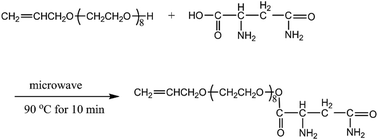Synthesis of acrylic acid-allylpolyethoxy amino carboxylate copolymer and its application for removing calcium from crude oil
Abstract
A novel environmentally friendly type of decalcifying agent acid, allylpolyethoxy amino carboxylate (AA–APEA), was synthesized and characterized by Fourier transform infrared spectrometry (FT-IR) and 1H-NMR. AA–APEA was used to remove calcium from Luning pipeline crude oil. The effects of several factors, such as molar ratio, dosage and reaction temperature on calcium removal efficiencies from crude oil were evaluated. The optimum conditions for calcium removal from crude oil were as follows: (a) molar ratio of AA–APEA was 2 : 1, (b) dosage of AA–APEA was 150 ppm, and (c) reaction temperature was 120 °C. Under these conditions, the removal efficiency of calcium from Luning pipeline crude oils was approximately 98.78%.


 Please wait while we load your content...
Please wait while we load your content...